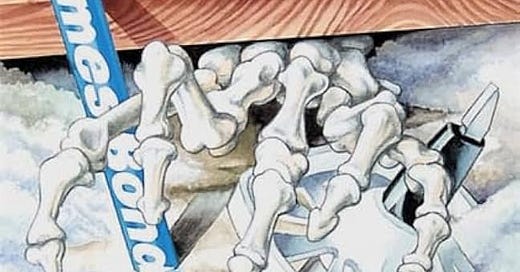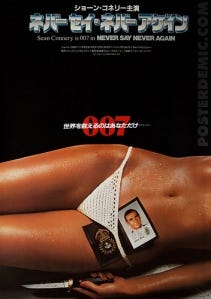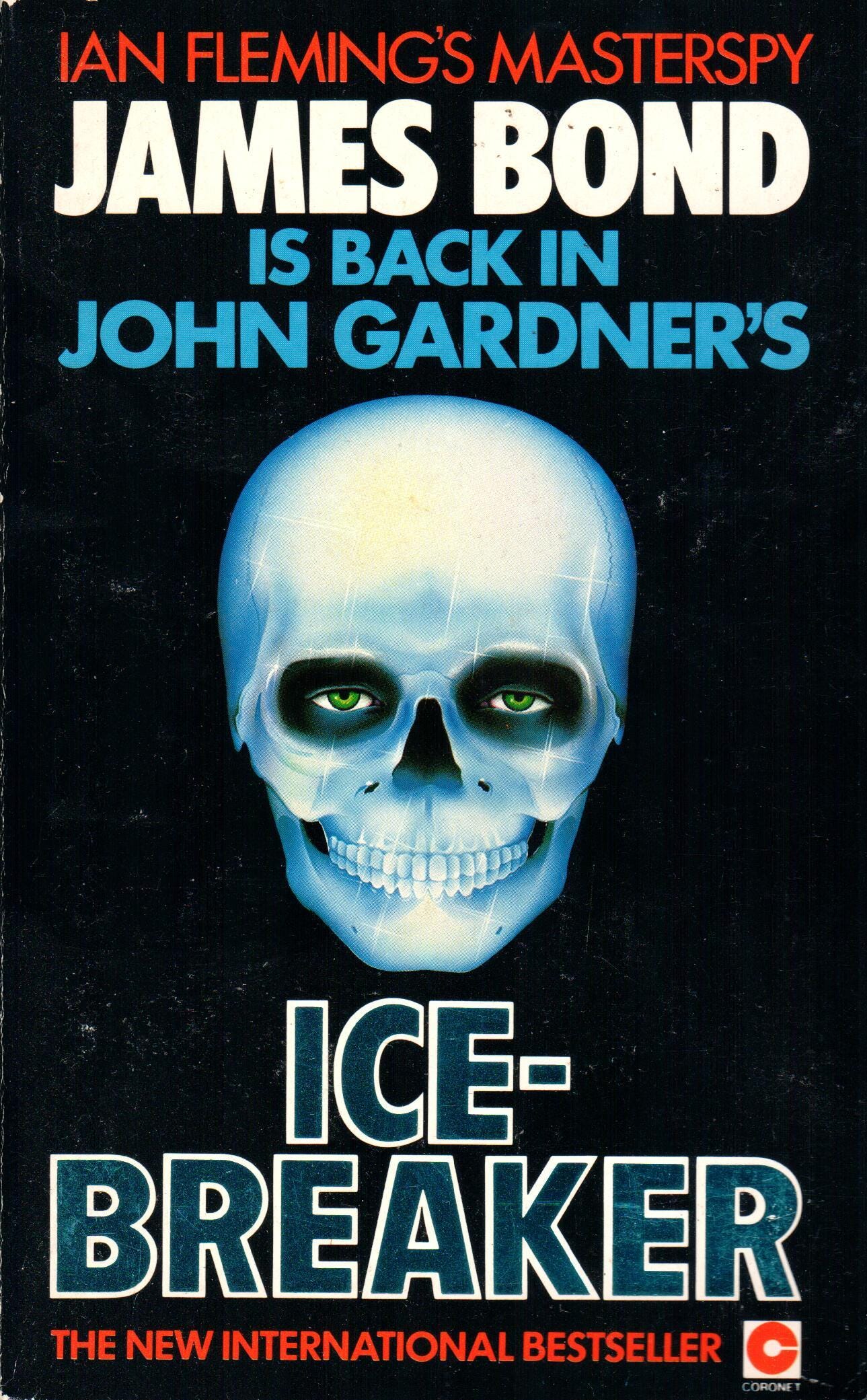Welcome to this weeks newsletter. I hope you’re all doing well. Today I continue my exploration of John Gardner’s James Bond continuation novels—this week: Icebreaker.
Book Review: Icebreaker
Author: John Gardner
Publisher: Jonathan Cape
Published: 1983
In my review of For Special Services, I detailed how it and John Gardner’s third continuation novel, Icebreaker, came into my life, so I won’t rehash that, but if you’ll forgive the self indulgence, I’ll relate another Bondian tale from that very same trip through Asia.
Like any tourist that hits Tokyo, a trip to the Ginza precinct was obligatory—so off the family went. During our travels, we happened across a cinema complex, with various film posters attached to the front window. We must have wandered slightly off the tourist trail, because the signs suddenly didn’t have English translations accompanying them. But little things like language weren’t really a problem unless you wanted to actually communicate with someone.
Unfortunately we ran into such a problem, when I spotted an advance poster for Never Say Never Again, featuring Sean Connery. It was a black poster, with the lower portion of a bikini clad women lying on her side. Tucked through the strap on her bikini bottom, was Bond’s I.D. With a picture of Connery. It was a great teaser, and being a spoilt brat, I really, really wanted this poster. Please forgive my youthful western arrogance.
So we approached a staff member – and my father did most of the talking – and offered a large amount of Yen for the poster. The staff member didn’t speak English but the international language of ‘Connery’ and money conveyed our intention. The staff member wanted to sell the poster, but was clearly not in a position to do so, and had to say no. We walked away empty handed. I still think it’s a great poster, and would love a copy mounted on the wall.
Before I get into Icebreaker, I thought I’d explain my perception of International editions of Gardner’s Bond books. Unlike Licence Renewed and For Special Services (and despite the Illustration above), I do not own a first edition, Jonathan Cape copy of Icebreaker. The edition bought in Taiwan, was based on the American (Putnam?) edition, and I guess it would read very much the same. However the English Coronet paperback edition is slightly different. Not a great deal, but for example the first four paragraphs in the American edition are grouped into one slab in the UK edition. Also some of the commas and other punctuation are moved around. Not that this matters too much, but it does alter the pacing slightly. Funnily enough, by the time of Nobody Lives Forever, there is some quite heavy handed editing in the passages—still telling the same story, but using a different turn of phrase. I am assuming that this is common practice for various international editions, where novels are edited to suit the market that they are being released in. I wonder what author’s think about this? I know from my own simple attempts at writing, I often will write and rewrite a passage attempting to convey the full extent of my message, and keep a certain flow or rhythm happening. Maybe I am being too precious, but after all that work, I be rather perturbed if an editor for another English speaking market, tinkered with a passage and diluted the impact. Note, I am not talking about editing to tighten up and improve the story, I am talking about tinkering with a book that has already been released and adjudged to be the best it can be.
English and American readers are probably asking ‘whatsit matter?’ The funny thing is in Australia, many of the books are imported from both the UK and America. If a book is likely to be a best seller, it will get a print-run here, but a large amount of literature is imported. If something is mega-successful, like Steig Larsson’s books, not only will they be printed here, but also to meet the demand (or sometimes because it is cheaper), they will also be imported. So we have that funny situation where you can move through a shopping centre and find three different versions of the same book. And getting back to my original point about different versions, for different markets, I find it surreal that I can walk into a shopping centre with a friend, and we each go our separate way to buy the same book, and then come back half an hour later with our copies to find them different. Not a big deal, just a fascinating curio in a world which seems to get smaller by the day.
But time to move on to the case at hand – Icebreaker. When I first read Icebreaker, I was hugely disappointed. My problem was that there just way too many double and triple crosses, with characters swapping identities and allegiances. Reading it now, I get a very different impression. Maybe because I know the twists that will occur. However, the book is still the weakest of the three initial Gardner continuation novels, but not for the reasons that annoyed me as a bushy tailed youngster.
Firstly, Bond slips into a 1960s Boysie Oakes style character, chasing all the ‘loverly’ blonde dolly-birds. There was always been a certain amount of sexuality in the Bond stories, but here the tone is wrong. Bond doesn’t seem like Bond, but more like a character from a Timothy Lea novel (or film). Maybe the opening chapter should have been called ‘Confessions of a … Super Spy’. Admittedly, I am probably being a bit harsh there, it just didn’t gel with me. I was rather happy that Bond’s interlude with Paula Vacker was interrupted by two thugs intent on killing him. The fight passage, like all of Gardner’s action sequences in very well handled and rockets along.
The other big problem with the story is the presentation of the villain. He is talked and theorized about for the first two-thirds of the book, but we don’t really meet him. As such, he doesn’t seem like much of a threat. In fact, the real threat to Bond in the constantly changing allegiances of his allies. But to understand all that, you probably need a brief overview of the novel.
In Icebreaker, James Bond is assigned to join a team of international operatives to finally track down and break a neo-Nazi organisation called the National Socialist Action Army or the NSAA for short. These guys have been traipsing all over the world killing anybody who deals or trades with the Eastern Bloc countries.
The team consists of Bond (of course), CIA Agent Brad Tirpitz (known as ‘Bad Brad’—due to his old school methods)’, Kolya Mosolov – a KGB operative, and Rivke Ingber, a Mossad Operative.
The alleged mastermind behind the NSAA is a gentleman known as Count Von Gloda—a man rumoured to be a wanted war criminal—a former SS officer, Aarne Tudeer.
The first twist comes when it is revealed that Rivke Ingber, is in fact the daughter of Tudeer. She claims that upon finding out about her father’s murderous Nazi legacy, converted to Judaism and trained with Mossad hoping to bring her renegade father to justice. The niggling thing here, is that her employer, Mossad themselves are not sure how much she can be trusted. For the first two thirds of this novels, Gardner keeps all the twists in the story under control. In fact they are enjoyable. Some are more expected than others. But then, it is almost as if Gardner assigned himself the task or literary challenge of implementing as many character twists as possible – that is the characters change allegiance; one minute they’re good guys, Bond’s allies, the next they are villains. The sheer number of switches eroded any credibility the story may have, and from that point on it becomes a literary exercise.
But as I alluded above, that’s not the problem. It’s Bond’s lack of interaction with the villain Von Gloda. Bond only meets him, after being captured, where he is brought him for some megalomaniacal gloating. And then, if you’ll pardon the ‘Incredibles’ reference, the villain starts monologuing.
Then Bond is dragged away to be tortured. And that’s it till the final showdown. Bond and Von Gloda don’t share a relationship – or more importantly Von Gloda and the readers don’t share a relationship. If an early passage in the book had described Von Gloda organising his villainous scheme—and incidentally killing one of his own minions for incompetence (just so we know he is evil)—then when Bond finally confronted Von Gloda there’d be a sense of fulfilled destiny. But instead, the head villain comes off as a secondary character.
This is also one of those stories where Bond seems to step into more traps than carrying out heroic deeds. Most of his daring escapes are aided by other characters—and therefore it could be argued in this story, he is a bit of a goose—in reality, he’s a pretty shit spy.
But it’s not all bad, Gardner handles the action well. There’s a very good passage, where Bond, in his car, The Silver Beast, is confronted by three snow plows—all intent on carving him up. And the final destruction of the villain’s lair, The Ice Palace, is pretty good too. Icebreaker is not absolute garbage, but it is a step down from the first two Bond novels by Gardner—so if you’re new to Gardner, I wouldn’t start with this one. It may give you the wrong impression of the series.
Yours in the Spirit of Adventure
That’s the end of this newsletter. I hope you’ll consider subscribing, and I’ll be back soon with more nonsense from inside the walls of Pentridge Prison. Until then, take care, David.
Australian adventure author, David Foster, writes under the pen names James Hopwood, A.W. Hart, and Jack Tunney. He has written seven novels, and his short fiction has been published in over 50 publications around the world.
David’s artwork has appeared in group exhibitions in Echuca, Shepparton and Bendigo. His one act play, Future Shock, was performed at Echuca Arts Centre in 1984.






I appreciate your review of Icebreaker , perhaps wanting to find the merit in it as the continuation of the Bond story but being objective on where it fails as literature. I guess the "Ice palace" was the villain lair used in the film 'Die another day'?. I also very much enjoyed your family travel anecdote about trying to buy the Bond poster in japan, and failing.